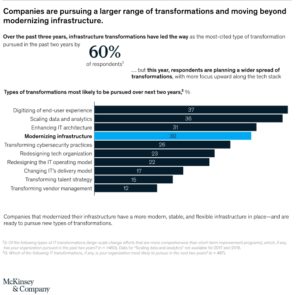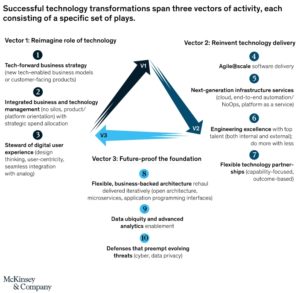A technology-transformation approach that works
Whether it’s been the shift to online working, the spike in online demand, or the increase in cyber assaults, technology has emerged as a critical business capability. That reality has injected a renewed importance and new urgency into modernizing the technology function. Companies can no longer afford the long timelines and often-disappointing business returns that have hampered many of the large tech-transformation projects of the past.
Instead, some technology leaders have pursued a new approach that is comprehensive enough to account for the myriad interlinkages of modern technology joined at the hip with the business so that change delivers value, and self-funded so that the scope of the change can continue to expand. We think of this comprehensive approach as “tech forward.”
Counteracting the most devastating tech-transformation failure modes
Some companies are starting to see real impact from their tech transformations. In a recent McKinsey study, some 50 percent of surveyed companies reported moderate to significant impact on realizing new revenue streams, almost 70 percent reported impact on increasing existing revenue streams, and 76 percent reported impact on reducing costs. 1
Tech transformations, nonetheless, remain notoriously difficult and complex. Though many companies are transforming their tech organizations, about 50 percent of them report that they’re still in the pilot phase (small tech teams working with advanced technologies but isolated from the rest of the technology function). 2
To understand better what successful tech transformations look like—as well as what the most important pitfalls are—we spoke with nearly 700 CIOs at some of the largest companies across the world. These conversations illuminated a number of consistent factors that most consistently kill off even the most promising tech transformations and revealed antidotes to address them. Following are three of the most common failure modes.
Piecemeal activity and limited scope
There is no shortage of technology-transformation initiatives, all of them with good intentions and promising payoffs. In fact, our latest analysis shows that companies are expanding the range of tech-related transformations (Exhibit 1).
…
What a ‘tech forward’ transformation looks like
Detailed conversations with CIOs as well as our own experience helping businesses execute complex technology transformations yielded a broad array of insights, best practices, and guidelines. We’ve synthesized them into a “tech forward” model that highlights three interconnected vectors, within which are ten specific “plays,” or domains of activity (Exhibit 2).
Vector #1: A reimagined role for technology that’s focused on the business
Vector #2: A technology delivery model built for flexibility and speed
Vector #3: A future-proof foundation of core tech systems that support innovation, collaboration, and security
To plot a company’s tech-transformation road map, we find the following questions particularly helpful:
- What is your expectation from technology?
- Which strategic outcomes are most critical (for example, speed and quality of delivery)?
- Which are the most urgent pain points and what causes them?
The following questions help executives understand the current state of the technology function and its experience with transformation programs:
- Which, if any, of the ten plays from the tech-forward approach are in place, and what is their maturity?
- Is transforming your company’s tech one of the top two priorities in your C-suite? If not, why not?
- How well does the technology function support your company’s strategic objectives or digital ambitions?
- What tech-transformation efforts has your company launched to date? What effect have they had? What went well, and what didn’t?
- What factors might restrict the pace of your tech-transformation efforts? In particular, how much capital and other resources can the company devote to tech transformation?
The current COVID-19 crisis, of course, is having a significant impact on how CIOs and businesses manage tech transformations. Despite the pressures it has added to costs, however, the urgency to get moving and transform has never been higher, according to many CIOs. But while the demands placed on the technology function have grown, so too have the opportunities. Experience suggests that the most effective transformations are not only comprehensive, covering the function’s role, delivery model, and core systems, but also sequenced to ensure that changes that reinforce each other are carried out together. With up-front planning focused on business value and careful delivery, a company can bring its technology function forward and gain the capabilities to thrive in challenging digital markets.
About the author(s)
Anusha Dhasarathy is a partner in McKinsey’s Chicago office, where Isha Gill is an associate partner and Naufal Khan is a senior partner; Sriram Sekar is a senior expert in the New Jersey office, where Steve Van Kuiken is a senior partner.
More: https://www.mckinsey.com/business-functions/mckinsey-digital/our-insights/how-to-become-tech-forward-a-technology-transformation-approach-that-works

